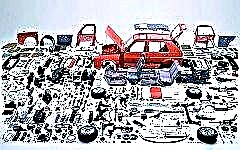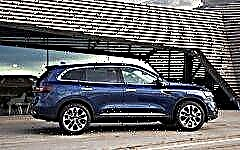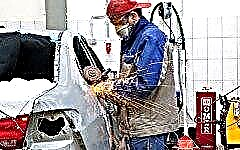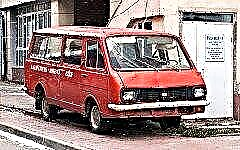

The content of the article:
- German inspiration
- Design features of the RAF
- Modifications
- Small spool, but very popular
- Ideas, no resources
- Safe RAF
- Mass distribution
- Olympic series
Minibuses of the RAF series for the first time left the assembly line since 1976 and instantly dispersed throughout the Soviet Union. What caused such a phenomenal popularity of these cars and their massive use in all spheres of activity?
German inspiration

The Soviet-Latvian enterprise was founded back in 1949. Since 1953, when the plant merged with an experimental automobile factory, it began to actively produce medium-sized buses. Before the triumphant march of the most popular models - 223 and its modifications - there were a number of experiments.
You should start with RAF-10, the prototype of future minibuses, which became the ideological inspirers and a kind of "test bench" for many technical developments. Although it was based on the Pobeda chassis, it was a full-fledged minibus, before the creation of which the designers carefully studied and were inspired by the simplicity and reliability of the design of Volkswagen vehicles.
They were seen by Soviet specialists during a trip to Europe to exchange experience, where the German auto industry was just gaining momentum and was almost a benchmark for other automakers.
For the development of RAF-10, which was produced from 1956 to 1958, the first generation Volkswagen Transporter model was "spied". The Soviet car received a steel monocoque body, a wagon layout and accommodated 10 passengers. However, this design received a number of complaints, and therefore underwent significant modernization in 1958.

The next stage was the release of RAF-977, which existed immeasurably longer than its "brother" - from 1958 to 1976. Its chassis was borrowed from the GAZ-21, while the minibus itself was used everywhere: for freight and passenger transportation, as a transport for medical services, but mainly as a service bus of various government organizations. In all areas, it has established itself as a reliable car, and, moreover, for that time, more than comfortable.

The famous RAF-2203 was produced from 1976 to 1997, and left the market only under pressure from the ever-increasing competition from the Gorky Automobile Plant.
Automakers began a fierce rivalry in the early 90s, modernizing and promoting each of their models - "Gazelles" and "RAF". Unfortunately, the former surpassed the Latvian creations in terms of their characteristics and cost, and therefore became leaders in the Russian car market.
A remarkable fact - it was originally planned to make the body of the minibus from fiberglass, but then this idea was abandoned.
Design features of the RAF

The best creation of the car plant - model 2203 - was made with a load-bearing or frameless power base, which included:
- spars;
- front shield;
- wheel arches;
- wagon or cabover body layout.
The salon was divided into two parts: the front one, located above the wheels and consisting of a well-equipped driver's seat and passenger seat, and the rear one in the largest part of the car. Depending on the specific requirements, seating or other structural elements can be placed there.
The engine for the minibus, axles and suspension are borrowed from the GAZ-24 car, in later versions - from the GAZ-24-10. The brake system has two circuits, all wheels are equipped with brake drums, and the hydraulic vacuum brake booster is taken from the Moskvich-412.
Like a complex constructor, it consisted of many elements taken from other domestic cars. Even the seemingly unique steering is still developed with the borrowing of parts from GAZ passenger models. The engineering and design team of the plant explained this approach by the simplicity of car maintenance.
The tires were original, specially designed for RAF-2203, although wheels from GAZ-21 were also suitable. "Exclusive" tires for a minibus were produced by a tire plant in Yaroslavl, and after the collapse of the Soviet Union, they began to install any wheels suitable for the landing diameter and height.
Modifications

During production, several modifications of the minibus were developed, differing in technical features, as well as the possibility of operation. Far from all the developed versions reached serial production, especially with regard to the options that were worked on in 1990-1995.
Some versions turned out to be simply not suitable for practical use, such as, for example, a modification with original taillights, which did not imply a separate replacement of lamps. Thus, in the event of a malfunction of one lamp, the entire lantern would have to be replaced, which seemed extremely inconvenient and costly.
Therefore, this modification never went into mass production.
Some varieties were produced in small batches to cover the specific needs of the national economy.... Mostly, the models changed and improved some technical elements, most often the suspension, which increases the level of comfort. Objectively, no radical changes were noted between the different modifications.
Small spool, but very popular

The first version of the RAF-2203 bus is considered basic and has two main modifications. The first - with the original dashboard and sidelights from the GAZ-24. The second used a dashboard from a GAZ-24, as well as optical instruments standard for those years from other serial buses.
The first generation of this car was produced until 1986, after which the quality of the produced copies began to deteriorate rapidly. Many complaints were received from medical organizations, where minibuses were used as ambulances.
During operation, it turned out that even completely new models, literally received from the assembly line, could break down on the road for no apparent reason. An example of poor quality is the fact that in February 1986 the state commission did not accept 13% of these cars.
Ideas, no resources

The result of the disputes about quality was the technical re-equipment of the plant and the subsequent release of a new modification of the RAF, which included certain novelties of that time. Unfortunately, the plant's capacity did not allow to introduce all the planned innovations, therefore the engineers had to focus on the key points:
- reinforced body;
- sunroof and side vents on the rear windows;
- disc brakes on the front wheels;
- front suspension of the "swinging candle" type.
In addition to these changes, the new version received a more economical ZMZ-402.10 engine, which not only turned out to be more than not demanding on fuel, but also improved throttle response on the road.
After the collapse of the USSR, the demand for minibuses fell, although the management of the plant tried to make on the basis of RAF-2203-01 an all-metal van and a version in the form of a pickup truck, which was in great demand at that time. The consumers liked these cars, but the plant did not have enough resources to completely transfer the conveyors to the assembly of new models.
Safe RAF

In 1994, another upgrade was made. It can hardly be called global, but it made the RAF-22038-02 minibus the safest in the country. He received the following changes:
- one brake booster instead of two, which reduced the risk of failures;
- modified carburetor, which supplies fuel more efficiently;
- modern air filter;
- new heating system;
- inertial seat belts;
- spherical rear-view mirrors;
- insulation of the motor.
There were also copies with a modified suspension and a different body, but again financial difficulties did not make it possible to introduce all these innovations into mass production.
The last revision, for which there were enough resources, were all-plastic bumpers. In 1997, production was stopped due to the loss of the sales market.
Mass distribution

The so-called "RAFiki" were produced in the USSR only for state structures and enterprises, not going on free sale. In this regard, the models were divided into several main series, some of which were intended for strictly limited use:
- ambulances;
- route taxis;
- Olympic series specially designed for work in Moscow in 1980;
- police cars.
There were also other small series, since in the absence of alternatives to these minibuses in the USSR, they had to be used for almost any need. Often on the roads one could find specimens modified in workshops performing highly specialized functions.
The most common modification was the medical one. This version was labeled RAF-22031 and was initially produced on the same assembly lines with the rest of the varieties. Later, a separate conveyor was allocated for the assembly of ambulances.
The main difference from the "civilian" versions was the interior upholstery, which was made of light brown leatherette. There was also a partition between the passenger compartment and the driver's compartment, complete with sliding glass. Two lanterns with a red cross were mounted on the roof, as well as a search lamp designed to search for an address at night. A blue flashing beacon was a must.
There were also more specialized models, for example, for blood transfusions or resuscitation vehicles. But they were produced in extremely limited quantities.
To operate as small passenger buses, better known as "minibuses", standard modifications were usually used. Also, as an experiment, there were specially designed RAF-22032, which had a ticket office, a circular layout and distinctive signs of belonging to passenger transport. But such buses did not enter the series, mainly minibuses were based on the RAF-2203.
In the early 1990s, a version of RAF-22039 was produced, specifically for route taxis. It was distinguished by its increased capacity and a fiberglass roof. This made it possible to reduce the weight of the car, and also, due to the increased capacity, increased the profitability of the routes.
There was a separate modification for mobile laboratories, it had additional batteries to power the instruments.
In limited edition, traffic police cars and fire brigade staff buses were produced.
Olympic series

It was RAFik who was honored to become the official vehicle of the 1980 Olympics, therefore, special versions of the car were developed for such a significant sporting event. The most interesting among them are the following:
- Referee electric car - intended for transportation of judges during marathon races. It accelerated to 30 km / h and had a cruising range on one battery of up to 100 km.
- Truck tractors RAF-3407 - for the movement of athletes, capable of towing up to two passenger trailers.
In total, about two hundred cars were produced for the Olympics.

The main advantage of RAFics was the unification of components with other cars popular at that time, which simplified maintenance. In addition, the minibus's advantage was its excellent maneuverability, even despite the rather wide base from the Volga. The disadvantages include poor weight distribution and a criticism of build quality, which led to problems with the operation of even new cars.
In 2018, information about the restoration of the plant was leaked to the press. It is assumed that, together with European manufacturers, minibuses and city electric buses, compact buses with electric motors and even trolleybuses will be produced there.
The plans also include the creation of a series of vehicles built on a single base and having the characteristics of both a trolleybus and a bus. The unusual design will be able to move both on its own power reserve and be recharged from the city power grid.
If the investments in production pay off, you can count on a new "golden age" of the Baltic miracle - the RAF minibus.











